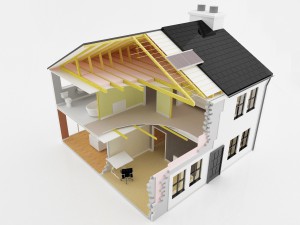 Spray polyurethane foam (SPF) insulation can increase the energy-efficiency of a home by creating a sound building envelope, which shields the home’s living areas from the outdoor environment. Homes can lose as much as 40 percent of heating and cooling energy through cracks and gaps in the building envelope. SPF acts as an effective barrier against air leaks in common spots including walls, attics, floors, rim joists, crawl spaces and areas around doors and windows. Sealing such common air leaks and improving the building envelope can help reduce a home’s energy consumption, resulting in lower greenhouse gas emissions and consumers’ utility bills.*
Spray polyurethane foam (SPF) insulation can increase the energy-efficiency of a home by creating a sound building envelope, which shields the home’s living areas from the outdoor environment. Homes can lose as much as 40 percent of heating and cooling energy through cracks and gaps in the building envelope. SPF acts as an effective barrier against air leaks in common spots including walls, attics, floors, rim joists, crawl spaces and areas around doors and windows. Sealing such common air leaks and improving the building envelope can help reduce a home’s energy consumption, resulting in lower greenhouse gas emissions and consumers’ utility bills.*
Utilizing building envelope measures like SPF helps the home use less energy, regardless of the generation source, and allows builders and homeowners to use smaller HVAC systems. SPF is also valued for delivering consistent performance and savings and for being easily incorporated into a home or building during construction. Code officials can inspect the building envelope to give consumers confidence that the home is built to comply with code requirements and will perform as designed.
An efficient building envelope provides numerous benefits that extend beyond energy savings. Protecting the home from the outdoor environment can improve the building structure’s durability. Certain types of SPF insulation have been shown to improve the strength of walls and roofs and also guard against moisture intrusion, which helps protect indoor environments from mold growth.
SPF is an effective and valuable way to provide long-lasting thermal protection and improve the building envelope. To learn more about SPF insulation and its wide-ranging benefits, drop by the Spray Foam Coalition’s booth 720 at the ICC’s Building Safety & Design Expo!
*Savings vary. Find out why in the seller’s fact sheet on R-values. Higher R-values mean greater insulating power. See 16 CFR 460.19.





